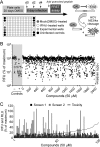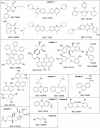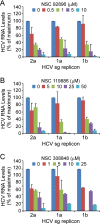Identification of hepatitis C virus inhibitors targeting different aspects of infection using a cell-based assay
- PMID: 22948883
- PMCID: PMC3497158
- DOI: 10.1128/AAC.01413-12
Identification of hepatitis C virus inhibitors targeting different aspects of infection using a cell-based assay
Abstract
With 2 to 3% of the worldwide population chronically infected, hepatitis C virus (HCV) infection continues to be a major health care burden. Unfortunately, current interferon-based treatment options are not effective in all patients and are associated with significant side effects. Consequently, there is an ongoing need to identify and develop new anti-HCV therapies. Toward this goal, we previously developed a cell-based HCV infection assay for antiviral compound screening based on a low-multiplicity-of-infection approach that uniquely allows for the identification of antiviral compounds that target cell culture-derived HCV (HCVcc) at any step of the viral infection cycle. Using this assay, here we report the screening of the NCI Diversity Set II library, containing 1,974 synthesized chemical compounds, and the identification of compounds with specific anti-HCV activity. In combination with toxicity counterscreening, we identified 30 hits from the compound library, 13 of which showed reproducible and dose-dependent inhibition of HCV with mean therapeutic indices (50% cytotoxic concentration [CC(50)]/50% effective concentration [EC(50)]) of greater than 6. Using HCV pseudotype and replicon systems of multiple HCV genotypes, as well as infectious HCVcc-based assembly and secretion analysis, we determined that different compounds within this group of candidate inhibitors target different steps of viral infection. The compounds identified not only will serve as biological probes to study and further dissect the biology of viral infection but also should facilitate the development of new anti-HCV therapeutic treatments.
Figures





Similar articles
-
Novel cell-based hepatitis C virus infection assay for quantitative high-throughput screening of anti-hepatitis C virus compounds.Antimicrob Agents Chemother. 2014;58(2):995-1004. doi: 10.1128/AAC.02094-13. Epub 2013 Nov 25. Antimicrob Agents Chemother. 2014. PMID: 24277038 Free PMC article.
-
Identification of novel anti-hepatitis C virus agents by a quantitative high throughput screen in a cell-based infection assay.Antiviral Res. 2015 Dec;124:20-9. doi: 10.1016/j.antiviral.2015.10.018. Epub 2015 Oct 26. Antiviral Res. 2015. PMID: 26515788 Free PMC article.
-
Development of a cell-based hepatitis C virus infection fluorescent resonance energy transfer assay for high-throughput antiviral compound screening.Antimicrob Agents Chemother. 2009 Oct;53(10):4311-9. doi: 10.1128/AAC.00495-09. Epub 2009 Jul 20. Antimicrob Agents Chemother. 2009. PMID: 19620334 Free PMC article.
-
Chemical genetics-based development of small molecules targeting hepatitis C virus.Arch Pharm Res. 2017 Sep;40(9):1021-1036. doi: 10.1007/s12272-017-0949-3. Epub 2017 Aug 30. Arch Pharm Res. 2017. PMID: 28856597 Review.
-
The hepatitis C virus life cycle as a target for new antiviral therapies.Gastroenterology. 2007 May;132(5):1979-98. doi: 10.1053/j.gastro.2007.03.116. Gastroenterology. 2007. PMID: 17484890 Review.
Cited by
-
Identification of a broad-spectrum antiviral small molecule against severe acute respiratory syndrome coronavirus and Ebola, Hendra, and Nipah viruses by using a novel high-throughput screening assay.J Virol. 2014 Apr;88(8):4353-65. doi: 10.1128/JVI.03050-13. Epub 2014 Feb 5. J Virol. 2014. PMID: 24501399 Free PMC article.
-
Repurposing of the antihistamine chlorcyclizine and related compounds for treatment of hepatitis C virus infection.Sci Transl Med. 2015 Apr 8;7(282):282ra49. doi: 10.1126/scitranslmed.3010286. Sci Transl Med. 2015. PMID: 25855495 Free PMC article.
-
Secondary Structural Elements of the HCV X-region Involved in Viral Replication.J Clin Transl Hepatol. 2015 Mar;3(1):1-8. doi: 10.14218/JCTH.2015.00003. Epub 2015 Mar 15. J Clin Transl Hepatol. 2015. PMID: 26356238 Free PMC article.
-
Novel cell-based hepatitis C virus infection assay for quantitative high-throughput screening of anti-hepatitis C virus compounds.Antimicrob Agents Chemother. 2014;58(2):995-1004. doi: 10.1128/AAC.02094-13. Epub 2013 Nov 25. Antimicrob Agents Chemother. 2014. PMID: 24277038 Free PMC article.
-
Identification of novel anti-hepatitis C virus agents by a quantitative high throughput screen in a cell-based infection assay.Antiviral Res. 2015 Dec;124:20-9. doi: 10.1016/j.antiviral.2015.10.018. Epub 2015 Oct 26. Antiviral Res. 2015. PMID: 26515788 Free PMC article.
References
-
- Afdhal NH. 2004. The natural history of hepatitis C. Semin. Liver Dis. 24(Suppl 2):3–8 - PubMed
-
- Ahmed A, Keeffe EB. 1999. Treatment strategies for chronic hepatitis C: update since the 1997 National Institutes of Health Consensus Development Conference. J. Gastroenterol. Hepatol. 14(Suppl):S12–S18 - PubMed
-
- Ahmed-Belkacem A, et al. 2010. Silibinin and related compounds are direct inhibitors of hepatitis C virus RNA-dependent RNA polymerase. Gastroenterology 138:1112–1122 - PubMed
-
- Alter HJ, Seeff LB. 2000. Recovery, persistence, and sequelae in hepatitis C virus infection: a perspective on long-term outcome. Semin. Liver Dis. 20:17–35 - PubMed
-
- Armstrong GL, et al. 2006. The prevalence of hepatitis C virus infection in the United States, 1999 through 2002. Ann. Intern. Med. 144:705–714 - PubMed
Publication types
MeSH terms
Substances
Grants and funding
LinkOut - more resources
Full Text Sources
Other Literature Sources
Medical

